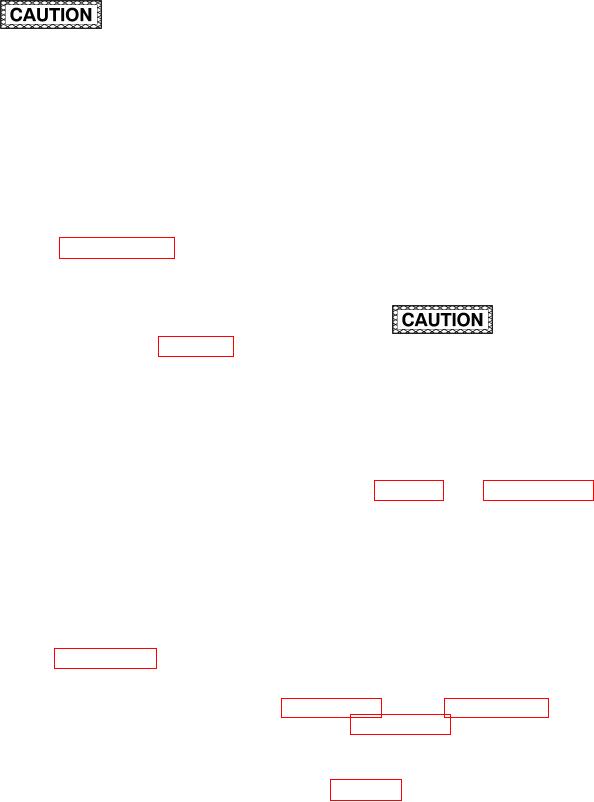
TM 1-1500-204-23-11
cycle. Use the hottest thermocouple as
the control and the coldest thermocou-
ple(s) for monitoring purposes.
Do not overheat any part. Elevated temper-
(4) Solutions to Heat Sink Problems. Several
atures can damage aluminum, sealant, paint
methods to minimize heat being conducted away from
and other composites. Ensure all materials
the repair area have been found to be effective to
in the heat-affected zone can withstand the
include insulation, heat blanket selection, and applying
temperatures used for the curing process.
backside heat.
Do not exceed a temperature of 300 F on
(a) Insulation. Additional insulation can be
any aluminum part. If the aluminum is shot
placed over the repair area. This insulation can
peened, do not exceed 200 F.
also be extended beyond the repair area to minimize
heat being conducted away. Breather materials and
(i)
Heat the repair area to the cure tem-
iberglass cloths work well, either on top of the vacuum
perature using the recommended ramp
bag or within the vacuum bag or on the accessible
rate; see paragraph 6-19, Curing
backside of the structure. Place more insulation over
Advanced Composites. Once the repair
cool spots, and less insulation over hot spots.
area has stabilized at the cure temper-
ature, record the TC temperatures. The
repair temperature has stabilized when
there is no rise in the bondline temper-
ature over 10 minutes. See igure 6-35.
To prevent heat damage to part, 100 percent
If drafts are present, temporary screens
contact must be maintained between heat
may have to be erected to prevent
blanket and part contour.
cooling to the repair area. The same
screens will need to be used during the
(b) Heat Blanket Selection. Heat blankets
cure.
can aid fabricating with varying watt densities and mul-
tiple zones (must be run with multiple-zone hot bonder
(j)
Examine the temperature readings in
controllers) to accommodate heat sinking underlying
the bondline. If they are within the limits
structures. See Chapter 3 and paragraph 6-19.
speciied in the system speciic techni-
cal manual, the thermal survey is com-
(c) Backside Heat. If the backside of the
plete. If the system speciic techni-
structure is available, additional heat blankets, heat
cal data does not specify an acceptable
lamps, hot air modules and such may be used. Heat
range, ensure the bondline TCs are 20
pucks may also be used to heat surrounding structure
F; if not, do the following:
discreetly.
(k) If the temperature readings within the
6-19. CURING ADVANCED COMPOSITES. This
bondline vary more than 20 F from the
paragraph provides fundamental information in regards
average, add insulation or heat in accor-
to the heating process which is used for moisture
dance with paragraph 6-18g. Repeat
removal and resin cure. Primary focus is on resin
the thermal survey.
curing; however, the heating principals also apply
to paragraph 6-6, Drying; paragraph 6-18g, Thermal
(l)
If the temperature readings within the
Survey; and paragraph 6-18f, Vacuum Bagging. This
bondline are within 2 F from the bond-
paragraph is used to accomplish the repairs in the
line average but they are lower than
following sections or in the system speciic technical
the acceptable cure temperature, raise
manual. For more information on the equipment cited
the cure temperature setting on the hot
here, see Chapter 3, Tools, Equipment, and Supplies.
bonder. Continue or repeat the thermal
Adhesives and resins can be cured in many ways.
survey until satisfactory temperatures in
The traditional approach used by the aircraft industry
the bondline are obtained in the thermal
is to accelerate the curing process by applying heat
survey.
while applying pressure. Typical aircraft adhesives
and resins are cured at temperatures above 150
(m) Record the exact setup to include the
F. Heat accelerates the reaction for most two part
position and intensity of heat sources,
adhesive systems. Heat can be applied by means
insulation, and hot bonder cure settings.
of heat blankets, heat guns or heat lamps. In most
In general, only the hottest and cold-
repairs in the ield, heat is provided by a heat blanket.
est thermocouples will be required for
Proper application of pressure and heat is essential
the required for the subsequent cure
6-70

